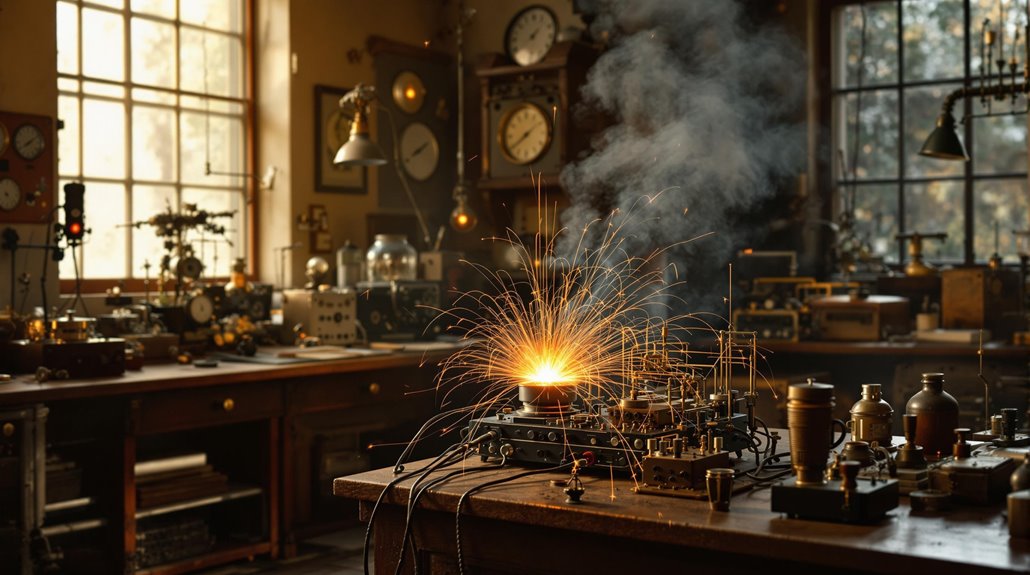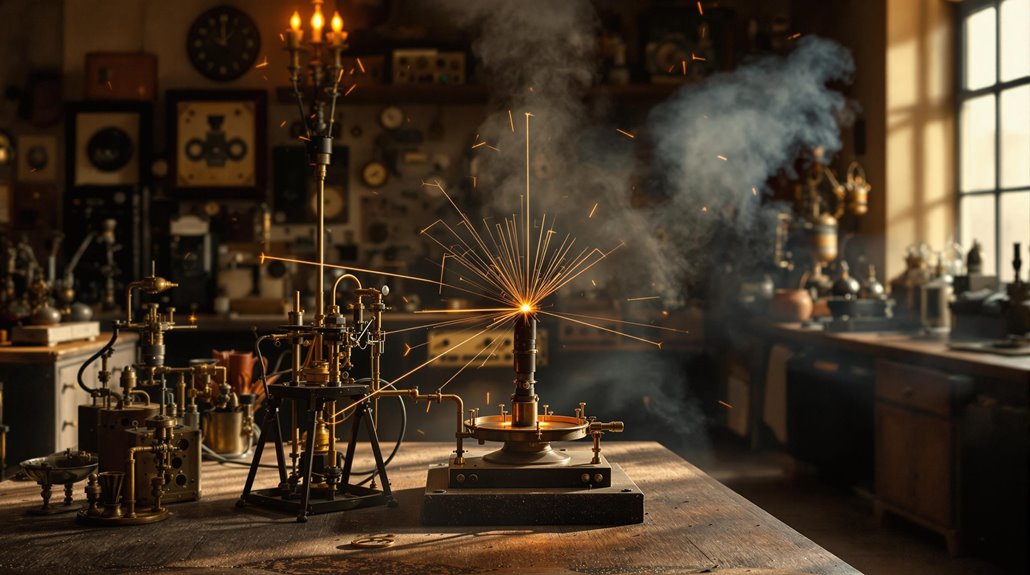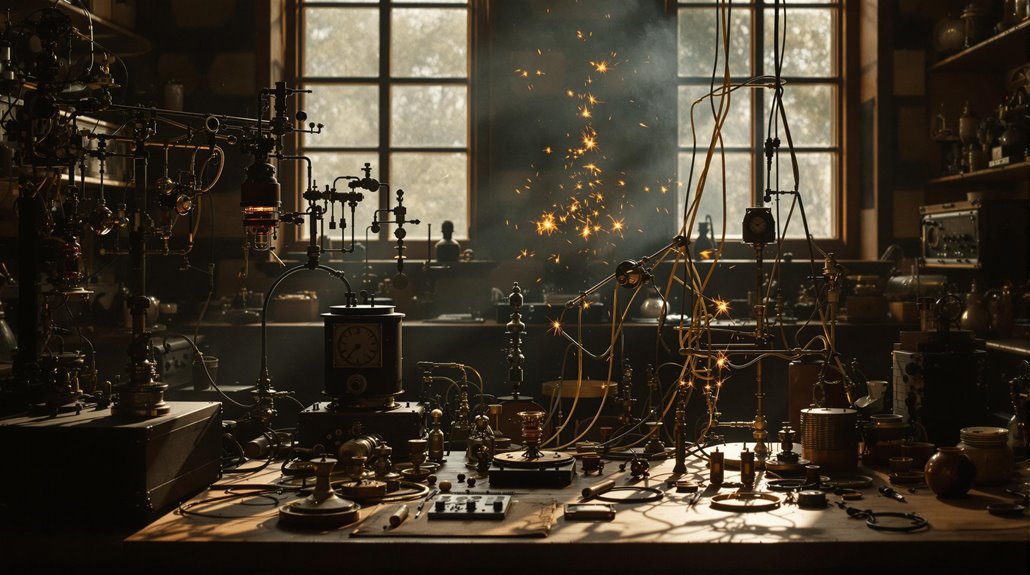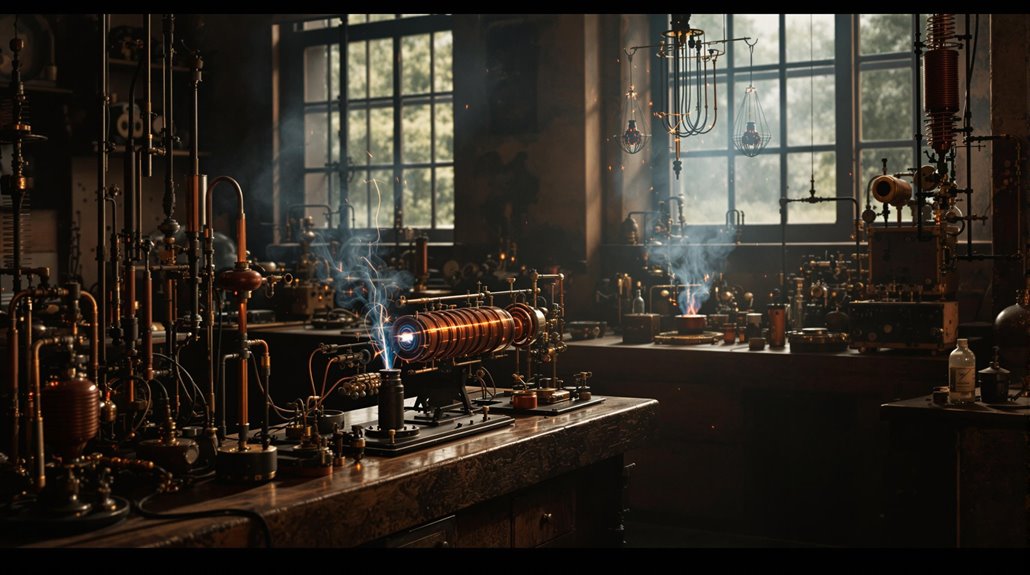Heinrich Hertz’s Accidental Sparks: The Sizzling Lab That Heralded Radio
You've likely sent countless texts and made numerous calls today without giving it a second thought. Yet behind this wireless convenience lies an extraordinary tale of sparks, brass loops, and one scientist's determination to prove what many thought impossible. Heinrich Hertz didn't set out to revolutionize human communication, but his accidental discovery in a modest German laboratory would transform theoretical physics into the foundation of our connected world.
The Serendipitous Spark That Started It All

While demonstrating Riess spirals to his students in October 1886, Heinrich Hertz noticed something that would change the course of scientific history.
As sparks jumped between the gaps in these electrical circuits, you could see his spark fascination growing with each electrical discharge.
This seemingly routine demonstration would inspire Hertz to create his first experimental apparatus. He began connecting induction coils to generate controlled sparks, adding a secondary spark-gap to study the phenomenon more closely. Like his early days in Hamburg, where he built a spectroscope, his drive for hands-on experimentation proved invaluable.
What he discovered was remarkable – when he adjusted the connection points of his side-circuit, the sparks behaved in unexpected ways. Most intriguingly, they'd stop completely when the wire lengths were equal, suggesting that waves of electric charge were racing through the circuits. His experiments would eventually lead to a circuit operating at 100 MHz frequency, demonstrating the first controlled radio wave transmission.
It was this simple observation that would eventually lead to radio's invention.
Inside Hertz's Groundbreaking Laboratory Setup
The genius of Hertz's laboratory setup lay in its elegant simplicity. His transmitter design combined an induction coil with a spark gap between meter-long copper wires, topped by zinc balls that provided essential capacitance. Skeptical scientists initially doubted the existence of radio waves until his breakthrough experiment.
You'd find a Leyden jar connected to the coil, generating high-voltage pulses at 100 MHz. After years as Helmholtz's research assistant, his expertise in electromagnetic experimentation became evident in his methodical approach.
The receiver configuration was equally ingenious – a brass wire loop just 7.5 cm in diameter with its own spark gap, positioned 1.5 meters from the transmitter. You could fine-tune the gap using a micrometer for ideal wave detection.
To enhance his experiments, Hertz added parabolic reflectors and polarizing filters, while using a zinc plate to create standing waves. His setup even included rotating mirrors to measure wave velocity, proving electromagnetic waves traveled at light speed.
From Theory to Reality: Maxwell's Predictions Come Alive
James Clerk Maxwell's revolutionary electromagnetic theory remained an elegant mathematical framework on paper for over twenty years until Hertz brought it to life.
In his laboratory, Hertz masterfully transformed Maxwell's complex equations into tangible reality, proving that electromagnetic waves could indeed travel through space at light's speed.
You'll appreciate how Hertz's experimental validation didn't just confirm Maxwell's predictions – it revealed an entire electromagnetic spectrum beyond visible light.
By generating and detecting radio waves, he demonstrated that these invisible forces could propagate through empty space, exactly as Maxwell had theorized.
His success marked a pivotal moment where theoretical physics met observable phenomena, bridging the gap between mathematical elegance and practical application.
Using a spark gap transmitter, Hertz ingeniously created the first device capable of producing electromagnetic waves in a controlled laboratory setting. His experiments demonstrated how changing magnetic fields could produce electric fields, confirming a key principle of electromagnetic theory.
What started as sparks in Hertz's lab would soon revolutionize global communication.
The Art of Catching Invisible Waves
Catching invisible waves required Hertz's ingenious experimental design and meticulous attention to detail. You'd find his setup deceptively simple: a spark-gap transmitter with brass spheres facing a wire ring detector several yards away. Yet this arrangement revolutionized wave detection of invisible phenomena.
Under the mentorship of Hermann von Helmholtz, Hertz developed his rigorous approach to experimental validation.
Between 1886 and 1889, Hertz conducted his groundbreaking wave experiments at roughly 50 MHz frequency.
In his darkened laboratory, you'd see Hertz methodically placing his detector at various positions, watching for tiny sparks through his microscope. Using metal reflectors, he created standing waves to measure wavelengths, while rotating mirrors helped determine their velocity.
His experiments proved these waves could be reflected, refracted, and polarized – just like light. He'd even demonstrate how they passed through some materials while bouncing off others. Through wire grid filters and careful antenna positioning, Hertz showed these mysterious waves were distinctly transverse in nature.
A Revolution Beyond the Laboratory Walls

While Hertz's laboratory experiments were groundbreaking, their impact rippled far beyond the confines of his research space, sparking a technological and cultural revolution that would transform human civilization.
Though some doubted wireless technology's potential, with Sir William Thomson dismissing radio's future in 1897, history would prove such skepticism unfounded.
You're experiencing Hertz's legacy every time you use your smartphone or connect to Wi-Fi. His work laid the foundation for global connectivity, from Marconi's first radio transmission to today's satellite communications.
The technological evolution he sparked continues to shape your world through television, radar, and medical imaging.
His influence was so profound that scientists named both the unit of frequency and radio waves after him. When you're streaming music, video chatting, or browsing the internet, you're riding waves of electromagnetic radiation that Hertz first proved existed.
His accidental sparks ignited a communication revolution that's still expanding today.
The Modest Genius Who Changed Communications Forever
Despite his revolutionary discoveries, Heinrich Hertz remained remarkably humble throughout his short but brilliant career.
 Riess spirals and Leyden jars to generate electromagnetic waves.
Riess spirals and Leyden jars to generate electromagnetic waves.
You'll find his scientific perseverance reflected in the way he methodically worked in his Karlsruhe laboratory, uncovering the hidden influences of electromagnetic waves that would transform our world. Originally pursuing architecture and engineering, he found his true calling in physics after switching his studies.
His commitment to pure research, without concern for practical applications, exemplifies the true spirit of scientific inquiry.
His lasting impact on communications can be measured in three ways:
- His experiments definitively proved Maxwell's theories, validating decades of electromagnetic research.
- His work laid the essential groundwork for wireless technology, from radio to modern smartphones.
- His methodical approach to research influenced generations of physicists, demonstrating how careful observation leads to breakthrough discoveries.
Before his untimely death at 36, Hertz had already revolutionized our understanding of the electromagnetic spectrum.










